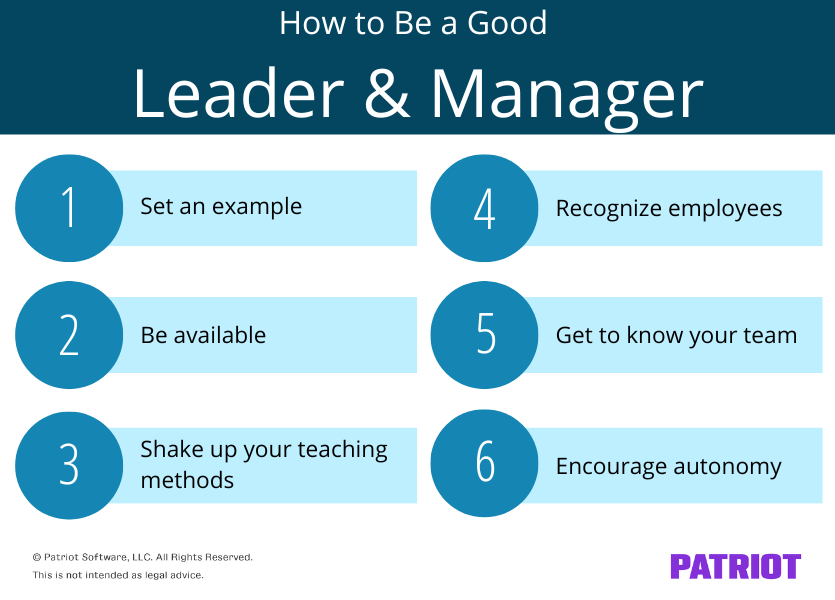You’re a savvy business owner with an unparalleled passion for your company. But, that doesn’t mean you’re automatically good at everything you need for business success, like accounting expertise, payroll knowledge, and leadership skills. Speaking of which … Do you know how to be a good leader and manager?
Only 10% of people are natural leaders, while an additional 20% have the potential for managerial talent. That’s not to say everyone isn’t capable of becoming a leader with a little training. But, 58% of managers said they didn’t receive any management training. Have you? Have your employees who are managers?
Read on to learn the basics of how to be a good boss—nay, how to be a great boss (capable of owning a classic “World’s Best Boss” mug!).
Why does knowing how to be a great boss matter?
Before we dive into the world of learning how to be a good team leader, let’s get down to the basics.
Why does it matter?
Take a look at just a few reasons why being a great manager and leader matters (complete with stats compiled by Zippia):
- Profitability
- Companies with employee engagement are 22% more profitable (and only 33% of employees say they’re engaged)
- For every year a company puts off leadership development, it costs 7% of their annual sales
- Attraction & Retention
- 35% of job seekers prioritize company culture
- 79% of employees quit due to lack of appreciation
- 50% say they’ve left a job to get away from a bad manager
- Productivity
- 69% of employees say they’d work harder if their efforts were better recognized
- Disengaged employees make 60% more errors at work
- Safety
- 60-80% of workplace accidents are due to stress, and poor leadership can contribute to stress
- Disengaged employees suffered 49% more accidents
How to be a good leader and manager
So, you want to know how to be a great manager and leader, eh? Take a look at the following six things to do, tips, and behaviors you need for the job.
(And if you have other team members who are managers, feel free to share with them, too!)

1. Set an example
Want to motivate your team? Reduce absenteeism in the workplace? Encourage them to stay late to hit a deadline? If you want all of this, you need to be willing to set an example.
As a small business owner, you’re probably a working manager, aka someone who leads teams and also does the work themselves. And as a working manager, you need to be a good worker yourself.
Show your team what you expect from them by expecting it—and more—from yourself. Of course, you likely do this already. Just make sure your team sees how it applies to them, too.
If you expect your team to put in paid time off requests a certain number of days in advance, do the same. And if you expect your team to put in extra hours to finish a project, don’t head out the door right at 5:00 p.m.
2. Be available
Nothing says bad manager like someone who’s always hovering over an employee’s work (aka a micromanager). At the same time, you don’t want to make yourself impossible to get a hold of.
Be available to answer questions or collaborate with employees without micromanaging. You can do this through:
- Having an open-door policy
- Setting up regular 1:1s with each member of your team
- Having a daily standup to touch base with employees
- Being available via email or an instant messaging platform (e.g., Slack)
Making yourself available to employees can strengthen communication, prevent errors, and encourage teamwork.
3. Shake up your teaching methods
Are you struggling to get through to an employee? Leading and managing is a lot like teaching—everybody is different. And like students, not all employees learn the same way.
Some employees are:
- Auditory learners (i.e., hearing the information)
- Visual learners (i.e., seeing the information)
- Kinesthetic, or hands-on, learners (i.e., doing an activity)
If something you’re doing isn’t working for an employee, dive a little deeper and find out what learning method resonates with them. Then, change up your approach.
4. Recognize employees
Don’t forget that 79% of employees quit due to lack of appreciation. That’s a shockingly high statistic. But, it’s relatively easy to fix.
Recognizing employees goes a long way. In addition to increasing retention, employee recognition and appreciation can boost productivity, increase morale, grow employees into leaders, and lower absenteeism.
There are several ways to recognize employees. You can keep things traditional or get a little creative.
Here are a few recognition ideas to get started:
- Give a simple shoutout to high-performing employees (e.g., using platforms like 15five)
- Show appreciation through gift cards or other tokens
- Have employee appreciation days
- Set up meetings to thank employees personally
The number one thing to remember when recognizing employees is to be genuine. Telling employees “good job” to hit your recognition quota isn’t the same as a heartfelt thank you—and your team will know the difference.
5. Get to know your team
How well do you know your small business employees? If you don’t want your employees to feel like cogs on a wheel, show them you care about them. And to do that, you need to get to know them.
What are your employees’ hobbies? Who are they outside of work? What are their likes and dislikes? If you don’t know, it might be time to find out.
Getting to know your team can:
- Highlight their strengths and weaknesses
- Reveal employees’ learning styles
- Help you better understand and manage employees
- Increase employee engagement and loyalty
You can better get to know your employees by making conversation at the beginning of meetings (it doesn’t have to all be work talk), gathering feedback, and setting up casual team lunches.
6. Encourage autonomy
How autonomous are your employees? Do they have the ability to work on their own, make decisions, and have true ownership of their work?
The majority of employees (52%) feel like they’re missing out on autonomy. But for employees to be autonomous, two things need to happen:
- Employees must be willing to work independently
- You must be willing to give employees autonomy
In short, autonomy is a two-way street. Employees and organizations need to be invested in autonomy.
You can encourage autonomy by showing employees how their work fits into the big picture (i.e., your business’s vision and mission). And, take a stand against micromanaging. Trust that your employees have the skills, knowledge, and experience to take true ownership of their work.
Remember, employees need to be willing to work independently for autonomy to happen. If you have employees who claim they want autonomy but sit on the opportunity, you might need to reassess their role in your organization.
Not there yet? Steps on how to become a good manager
Being a good leader and manager takes time and effort. If you’re looking for actionable ways to take your skills up a notch, take a look at the following:
- Attend training sessions (e.g., webinars)
- Read leadership articles from experts
- Gather feedback from employees on your performance
Becoming a great leader and manager may not happen overnight. But, putting in the time and effort may be well worth it to increase retention, boost productivity, and cultivate a healthy workplace culture.



